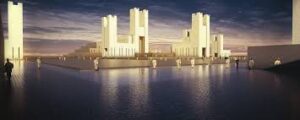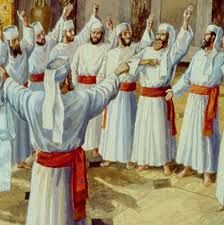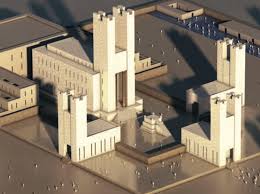God Shows a Vision of the Messianic Temple
Ezeki’el Chapters 40-48
This far eschatological prophecy was given on April 28, 573 BC during the exile.
It would be fulfilled after the Great Tribulation, during the Messianic Kingdom.
In many ways these chapters may be considered the most important in the book of Ezeki’el. They assuredly form the climax and crowning experience in the life of the prophet. His book begins with a vision of the Sh’khinah glory (to see link click Es – Ezeki’el’s Call to Be a Prophet) and concludes with the same vision. This last section of Ezeki’el is separated from the earlier part of the book by an interval of twelve years (Ez 40:1-2).

Ezeki’el was once again transported in the spirit to Yerushalayim. Like Dante following Virgil’s footsteps, the prophet is led on a tour of the Messianic Temple that begins and ends at its eastern gate (to see a 3D video of the Messianic Temple click here). There he witnesses the return of the Sh’khinah glory that had left Solomon’s Temple shortly before its destruction in 586 BC. Ezeki’el is given detailed instructions for the Temple personnel, offerings, festivals, the prince and the allotment of land. Back at the eastern gate, he is shown a stream flowing from the Temple down to the Dead Sea, which waters and fertilizes the barren Judean wilderness (see the commentary on Isaiah Ge – Your Eyes Will See the King in His Beauty). The vision ends with a description of tribal territories and Zion.392
In the past these chapters have created some serious problems for Judaism. These chapters contain discrepancies and contradictions of the Five Books of Moshe, and use terms that do not occur elsewhere in the Torah. In reference to these difficulties, the rabbis of the Talmud (Men. 45a) remarked that only the prophet Elijah, who was to herald the final redemption of Isra’el, would be able to explain them satisfactorily. The Talmud (Shabbos 13b) relates that if it were not for Chananiah ben Chizkiyahu, the book of Ezeki’el would have been hidden away, for its words seem to contradict the Torah. What did he do? 300 barrels of oil for his lamp were taken into his chamber, where he sat until he resolved the contradictions. We know neither the problems with which he dealt, nor the solutions.
Therefore, it is obvious that Orthodox Judaism has had problems with the book of Ezeki’el because in these chapters dealing with the millrnnial system of sacrifices and the priesthood, clearly contradict a number of things stated in the Torah. And the root of the problem for Orthodox Judaism is twofold. First, Orthodox Judaism assumes that the Torah is to be eternal. And yet it is clear that if Ezeki’el’s statements were taken as true, they were violating the Torah. But the Torah was never intended to be eternal. Secondly, they were spiritually blinded to the messiahship of Yeshua. They did not realize that the Dispensation of the Torah (see the commentary on Exodus Da – The Dispensation of the Torah) had ended and the Dispensation of Grace had begun (see the commentary on Hebrews Bp – The Dispensation of Grace). So even though Orthodox Judaism has had problems with Ezeki’el and decided to accept it into the TaNaKh on the assumption that when Elijah comes he will explain these difficulties.
But this section has also presented certain problems for Amillennialists within the Church. The German theologian Carl Friedrich Keil (1807-1888), in the famous Keil and Delitzsch series wrote, “The prophets of the Old Testament do not merely predict the return of the Israelites to their own land and their everlasting abode in that land under the rule of the Messiah, but this prediction culminates in the promise that YHVH will establish His Temple in the midst of His redeemed people and dwell there with them and above them forever. And that all nations will come to the Sanctuary of the LORD upon Zion, year by year, to worship before the King, the LORD of hosts, and to keep the feast of Tabernacles. If then, if the Jews should ever again receive Palestine for its possession, even at or after its conversion to Christ, in accordance with the promise of God, the Temple, with its sacrificial worship, without necessity, will also be restored in Jerusalem. But if such a supposition is opposed to the teachings of Messiah and the Apostles and not to be understood literally, but spiritually or typically, it is an unjustifiable inconsistency to adhere to a literal interpretation of the prophecy concerning the return of Isra’el to the Land, when they believe in Jesus Christ.” Basically, he was saying that these chapters couldn’t be understood literally. To be fair, he wrote this book long before Isra’el became a state in 1948. He is criticizing those who do not believe in a literal return of Isra’el to the Land, but at the same time, does not believe in a literal interpretation of Ezeki’el 40-48. He says this is inconsistent and I agree. It was inconsistent for the premillennialists of that day to say that Isra’el would be literally restored to the Land but then spiritualize away Chapters 40-48. Just as the restoration passages are to be taken literally, so are these chapters concerning the sacrificial system in the Millennial Temple. Why would Ezeki’el give us such detailed measurements if his intent were not to take them in a literal way? Such detail was also given for the Tabernacle in the wilderness and Solomon’s Temple, both literal structures with spiritual truths. The spiritual truths, however, were based upon the literal construction. Unless we take these last nine chapters literally, they are rendered absolutely meaningless.
Only Dispensational Premillennialism has no problem with these verses. We accept Ezeki’el’s words literally; we take him seriously and anticipate these things being fulfilled. Just as we saw the First Coming prophecies fulfilled literally, we shall see the Second Coming prophecies fulfilled literally as well.393
Some of the most challenging verses in these chapters concern the millennial system of the priesthood and sacrifice. The priesthood will be restored (Ezeki’el 44:1-31). The prince, the resurrected King David (see the commentary on Revelation Fi – The Government of the Messianic Kingdom), will be an intermediary between the people and the priests. He will officiate over specific festival offerings of Isra’el (Ezeki’el 45:13-22).

The descendants of Phinehas: The Levitical priests, who are descendents of Phinehas (see the commentary on Ezra-Nehemiah Bh – Ezra Returns from Babylon: Ezra’s genealogy) down to Zadok, would be honored with a special ministry in the Messianic Temple (Ezekiel 40:46, 43:19, 44:15-39, and 48:11). They were the ones who guarded God’s Sanctuary when the Israelites went astray from Him. In First Samuel 2:31-36 we read how YHVH through Samuel prophesied that the house of Eli was to be deposed and replaced by a faithful priest. That was finally fulfilled in First Kings 2:26-27. Then in Second Samuel 8:17 we read that Zadok became the high priest under King David and remained loyal to David after Absalom revolted (2 Samuel 15:24-29). Furthermore, Zadok was also loyal to Solomon (First Kings 1:8, 32-39, 2:26-27, 35) and the descendents of Zadok remained faithful during the days of Isra’el’s apostasy. As a result of their past faithfulness they will be given a superior role in the ministry of the Temple during the Kingdom. The Zadokites are to come near to minister before Me; they are to stand before Me to offer sacrifices of fat and blood, declares Adonai ELOHIM (Ezeki’el 44:15-31).
Then in Ezeki’el 45:1-8 the Holy City is described. The prince, the resurrected King David, will have the land bordering each side of the area formed by the sacred district and the property of the City (see the commentary on Isaiah Ge – Your Eyes Will See the King in His Beauty). It will extend westward from the west side and eastward from the east side, running lengthwise from the western to the eastern border parallel to one of the tribal portions (Ezeki’el 45:7).394
Without doubt, the most controversial issue concerning Ezeki’el 40-48 is the sacrificial system. King David will provide the sin offerings, grain offerings, burnt offerings and fellowship offerings to make atonement for the Israelites (Ezeki’el 45:17). Jewish believers ask, “Since the Messiah has already died for our sins, why would the sacrificial system be reinstituted during the Messianic Kingdom?” Four points should be noted.
First, during the dispensation of the Torah animal blood never took away sin (Hebrews 10:1-4) they merely covered sin. They pointed to a more complete sacrifice, the sacrifice of the Passover Lamb, Yeshua Meshiach, which would take away sin.
Secondly, Ezeki’el is not the only one who talks about a millennial system of sacrifice (Isaiah 56:5-7, 60: 7-13, 65:20-23; Jer 33:18-22; Zechariah 14:16-21). So these prophecies need to be taken literally because we have several prophets saying the same thing.
Thirdly, this is not a reinstitution of the sacrificial system in the dispensation of the Torah. While there are some similarities, there are simply too many differences, too many contradictions, with the Mosaic system. For example, in the Ezeki’el system there is no high priest and no ark of the Covenant (see the commentary on Isaiah Db – The Nine Missing Articles in Messiah’s Coming Temple). The dispensation of the Torah has come to an end because of the death of Messiah.
Fourthly, the Millennial sacrificial system is a memorial. During the dispensation of Grace (see above) believers are instructed to participate in a physical observance, or communion, in remembrance of the death of Messiah. But for Isra’el in the Kingdom there will be a different memorial: the sacrificial system in the Dispensation of the Messianic Kingdom will serve the same purpose as communion in the Dispensation of Grace. It will be the, do this in remembrance of Me, for Jewish believers.395
The Bible spends more time talking about this future Temple, than it does Solomon’s and Herod’s Temple combined. The only structure that comes close to space given the Millennial Temple is the Tabernacle. Why did Ezeki’el take so much space to describe the Messianic Temple, especially since it has never been built? Here are two reasons. First, the Temple was the visible symbol of God’s presence among His people. The prelude to ADONAI’s judgment was when the Sh’khinah glory left Solomon’s Temple in Yerushalayim (Ezeki’el 8-11). The climax to her restoration as a nation will come when the Sh’khinah glory reenters the millennial Temple in Jerusalem (Ezeki’el 43:1-5). Secondly, the Millennial Temple will become the visible reminder of Isra’el’s relationship to YHVH through His New Covenant (see Eo – The Days are Coming, declares the LORD, When I Will Make a New Covenant with the People of Isra’el). Since ADONAI gave detailed instructions for building the Tabernacle to accompany His inauguration of the Mosaic Covenant (Exodus 25-40), it is not unusual that He would also supply detailed plans for His new center of worship to accompany the implementation of the New Covenant. The Messianic Temple will be the focal point for the visible manifestation of Isra’el’s new relationship with her God (to see a longer video concerning the Messianic Temple click here).396

Why is the Messianic Temple important for us today?
Here are eight suggestions.
1. The Messianic Temple is important because it will be the dwelling place of God on earth. The One True God dwelt among His people in the Tabernacle (Exodus 25:8) and in Solomon’s Temple (First Kings 6:13). And ADONAI promises once again to dwell among His people (Ezeki’el 43:7-9).
2. The Messianic Temple is important because of the truth it presents about the Person and the ministry of Yeshua Messiah. Just as with the Tabernacle in the wilderness (see the commentary on Exodus Eq – Christ in the Tabernacle), the articles within the millennial Temple and the Temple court present a picture of Christ as the light of the world (John 6:35), the bread of life (John 8:12), and a new way to God (Hebrews 10:20). In studying the Messianic Temple, we discover many redemptive analogies that help us understand and fully appreciate the truth of our salvation.
3. The Messianic Temple is important because of its place in Isra’el’s history . . . both past and future. The concept of the Temple is so important that archaeologists divide Isra’el’s history into two sections: The First Temple and Second Temple periods. Although the Second Temple was destroyed over two thousand years ago, religious Jews today still talk about rebuilding it, and the Jewish and Gentile believers of today look forward to the return of Yeshua Messiah and the institution of His one-thousand-year Kingdom on earth, which will include the Millennial Temple.
4. The Messianic Temple is important because of its place in the world’s future. Although most people do not realize it, Jerusalem is destined to become the future world capital: In the last days, the mountain of ADONAI’s house will be established as the highest mountain; it will be exalted above the hills. Many Gentiles will come and say, “Come, let us go up to the mountain of ADONAI, to the Temple of the God of Jacob (Zech 8:20-23). YHVH will teach us His ways, so that we may walk in his paths.” The Torah will go out from Tziyon, the word of ADONAI from Yerushalayim (Micah 4:1-2).
5. The Messianic Temple is important because one day it will replace the Dome of the Rock. There is only one place to build Isra’el’s future Temple, and that is on the site of its former Temple. Someday – probably at the beginning of the Messianic Kingdom – the news will reverberate around the world that the Dome of the Rock is being destroyed. That event will prepare the way for the rebuilding of the millennial Temple in fulfillment of prophecy.
6. The Messianic Temple is important because the counterfeit messiah, the antichrist, will build his own Tribulation Temple in an effort to steal God’s glory. During the Great Tribulation there will be a counterfeit Father (Satan), a counterfeit Son (the antichrist), a counterfeit resurrection (see the commentary on Revelation Dj – The Antichrist Seems to be Resurrected), a counterfeit Holy Spirit (see the commentary on Revelation Do – The Beast Out of the Earth: The False Prophet), and a counterfeit temple, the tribulation Temple (see the commentary on Revelation Bx – The Tribulation Temple). In the middle of the seven years of tribulation he will put an end to the daily burnt offering sacrifice and offering. And on the wings of the Tribulation Temple he will set up an abomination (Dani’el 9:27) that causes it to be spiritually deserted as far a God is concerned.
7. The Messianic Temple is important because believers will worship there during Messiah’s thousand-year reign on the earth. The prophet describes how the Zadokite priests will lead in worship in the Temple (see above). Jewish believers will worship there continually, and Gentile believers will send a delegation from their country once a year up to Jerusalem to worship King Messiah during Sukkot.
8. The Messianic Temple is important because it has the potential to encourage your spiritual life and motivate you in the service of the LORD. On many occasions, discouraged and weary believers have found that a study of the Temple brings a new enthusiasm and excitement about our part in YHVH’s plan for the ages.397



Leave A Comment